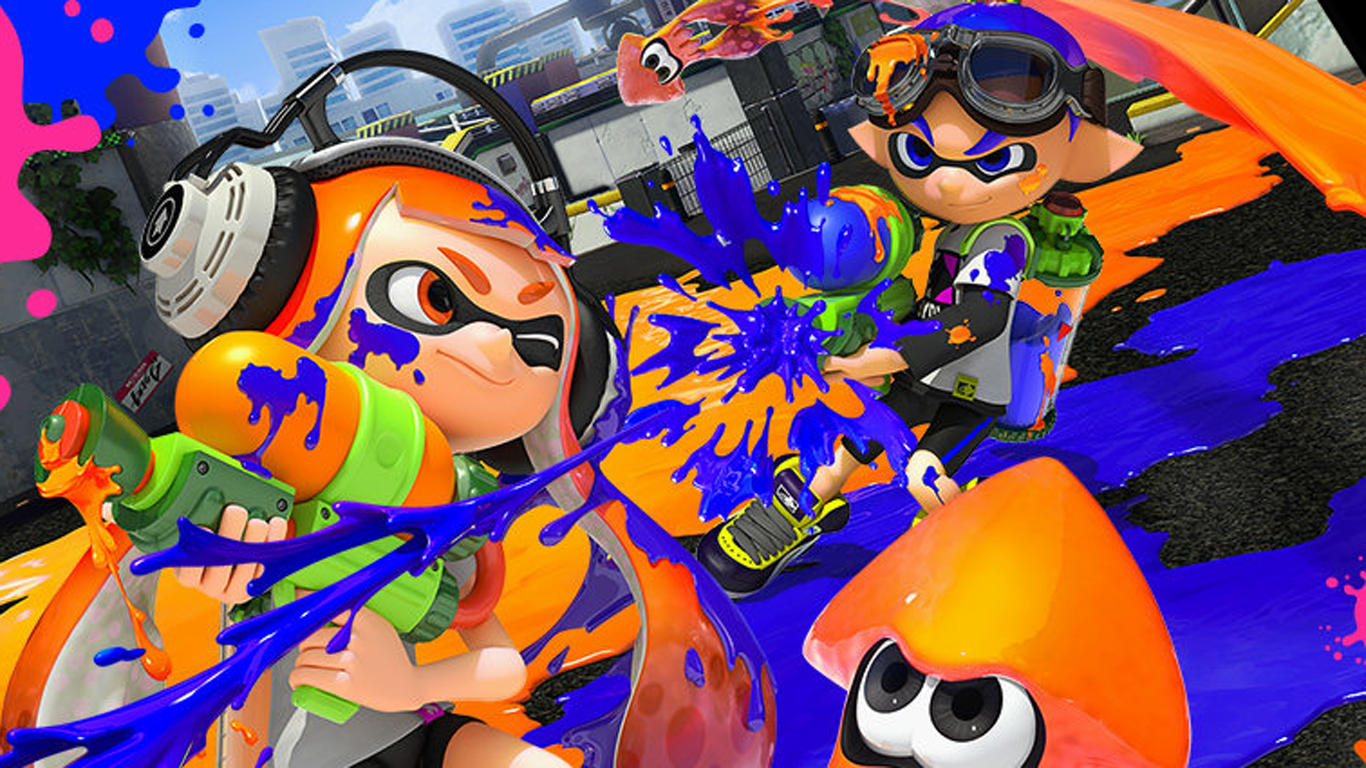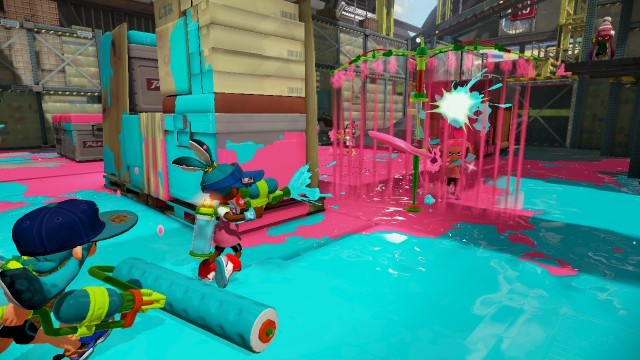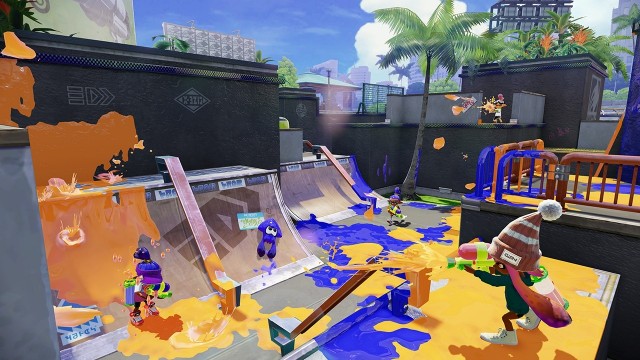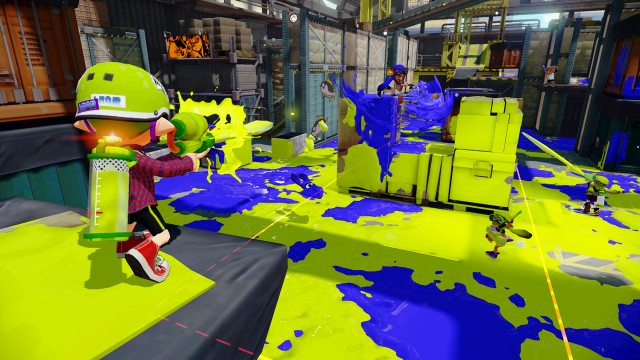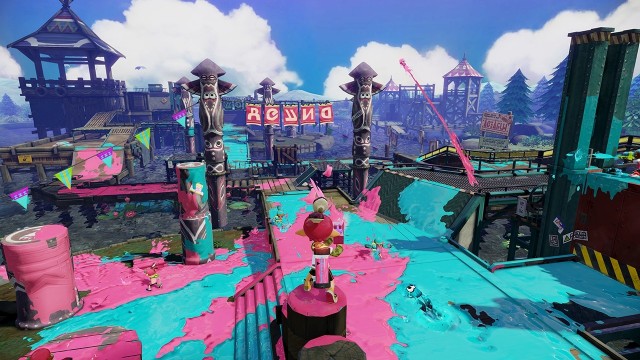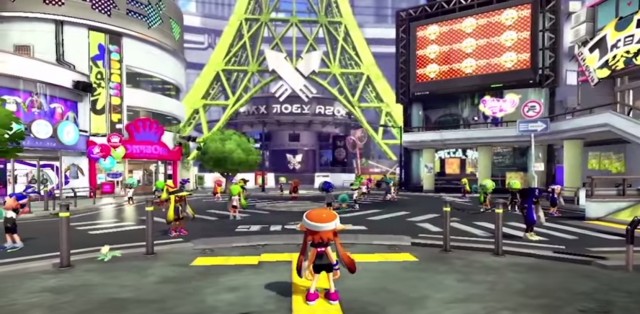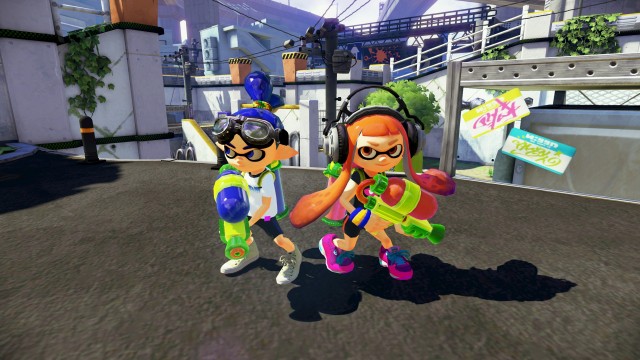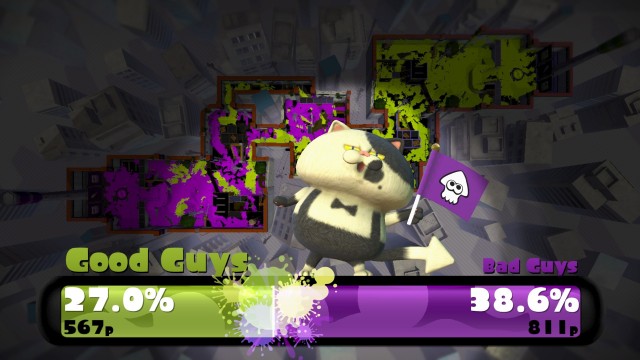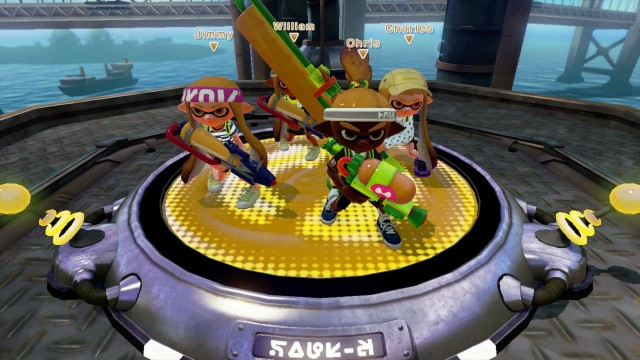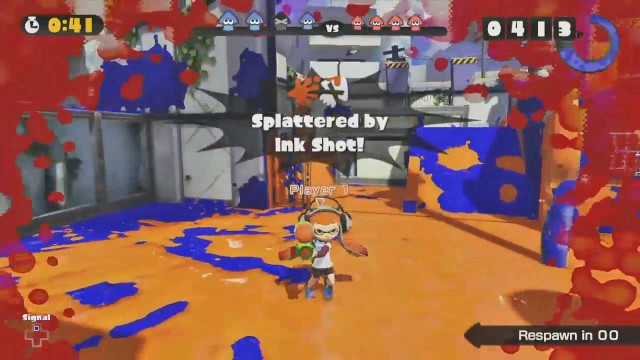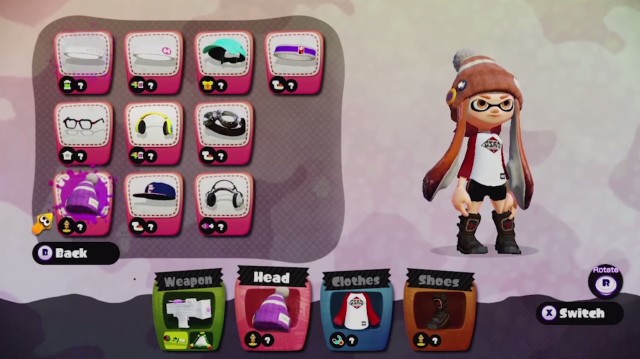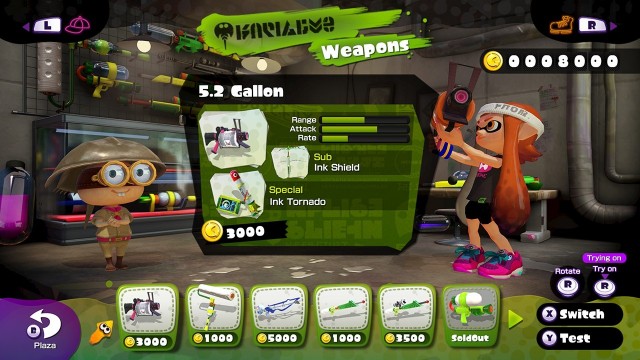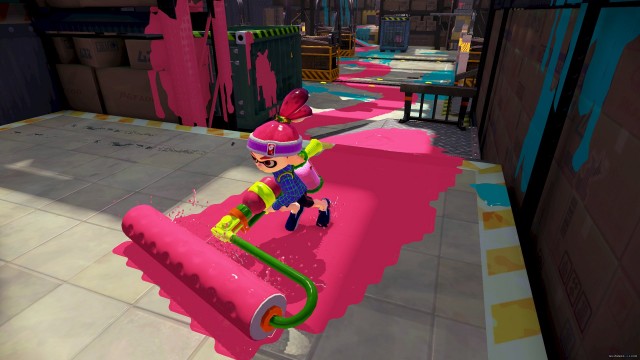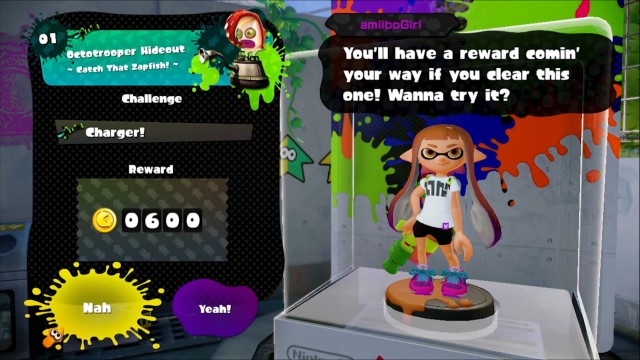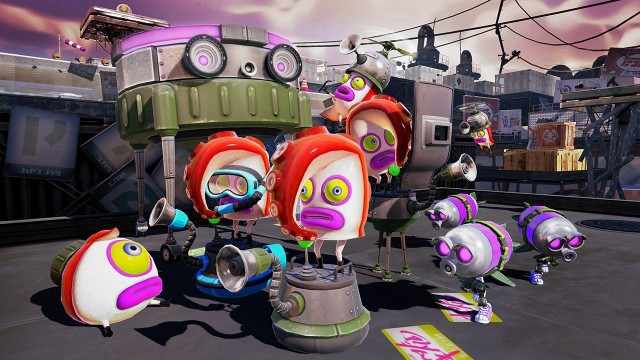Nintendo has continued to create plenty of interesting new IP’s on the Nintendo eShop, but it’s been a little while since the company has pushed a grand all-new triple-A IP for retail. Seeing as Nintendo has also pretty well entirely neglected the ultra-popular genre of online shooters, there was quite the stone ready to kill two elusive birds for the Big N. Herein now comes the pitch, and the result is a happy little game called Splatoon, one of the Wii U’s biggest new IP’s to date.
Seeing as this is Nintendo, Splatoon separates itself from the pack of online shooters immediately by shirking violence, along with the traditional idea of a ‘deathmatch’. Instead, the game unfolds in the style of a turf war, with players having to ‘ink’ as much territory as possible with their customizable humanoid squid avatars, called Inklings, and ambiguously send their opponents back to their base, should they manage to pepper them with enough opposing ink. It’s also a crazy amount of fun, creating one of the most surprisingly addictive Wii U multiplayer suites beyond Mario Kart 8 and Super Smash Bros. for Wii U.
As much as it looks awesome and plays in such a satisfying way however, Splatoon feels like it’s currently falling shy of its potential, on account of the game’s surprising lack of content. There’s only two maps in rotation at any one time, and the quick, simplistic matches, along with the complete removal of voice chat capability that most online shooter players take for granted these days, make Splatoon feel creative, but also largely lightweight compared to competing shooters. It’s not quite accurate to call it, “Baby’s first shooter”, since experienced adult online shooter players can still have plenty of fun with Splatoon, but this is still nothing that’s going to unseat Halo, Call of Duty or Battlefield in the competitive online game arena, not even close.
That said however, Splatoon makes for a more fun and accessible answer to those more widely-embraced online shooters, accommodating a wider and perhaps newer audience with fierce, but never hostile competition, as well as a satisfying alternative option for avid shooter gamers that crave something a little different. The base game feels like a bit of a shell so far, but with more maps and a wider range of gameplay, Splatoon could grow into something truly amazing for the Wii U’s legacy!
Splatoon immediately greets audiences with a well-rendered, very colourful look. The hub area of Inkopolis is incredibly detailed, harkening back to the stylized street cool graffiti-esque look of something like Jet Set Radio, and players’ Inkling avatars, while largely having the same base Inkling Boy or Inkling Girl models to choose from, can be outfitted with a variety of cool gear and weapons to help them stand apart. The fact that you can order gear from an in-game shop according to whatever other players are wearing in the hub area is a pretty cool idea on this note as well.
The maps in Splatoon all follow the same sort of urban template, but all of them look really vivid and sharp as well. There’s not many places to hide, seeing as hiding is discouraged in the turf war-style gameplay, but there’s plenty of little touches across the maps, whether graffiti or stickers or a nice variety of textures, that help each map sport its own sense of charm and character. It’s not the kind of diversity that you would find in a grand-scale Halo map roster, but these maps are nonetheless well-made and easy to navigate.
By far the best element of the graphics however are naturally the ink effects, which look absolutely amazing! The way that ink ripples, mats and seeps around as you spray around each area is absolutely stunning, with the bright array of potential ink colours further helping the game leap off of the screen, thanks to the Wii U’s sharp and mostly consistent native 1080p resolution capabilities. It’s also incredibly impressive to see how the ink physics react realistically to players turning into their squid forms and swimming through it, which can help tip off enemy players that someone is hiding and waiting to ambush them. Best of all is that all of this online action holds a virtually undisturbed 60fps clip of performance as well, making Splatoon unfold as quickly and furiously as a Call of Duty match. That’s very impressive for the lesser-powered Wii U!
Of course, the game’s single-player element looks amazing and runs at a perfect 60fps clip as well, with the single-player stages getting at least a tad more variety than the same urban backdrops that found the multiplayer maps. The models for the opposing Octarian enemies, and especially the bosses, look incredibly detailed and very colourful, making them stand apart, but sport no less polish than the main Inkling characters.
Even in the fiercest of online matches, Splatoon currently stands as one of the Wii U’s top visual stunners, particularly when it pretty well always keeps everything at 60fps in performance!
Splatoon has the kind of soundtrack that feels like it would feel right at home on Nickelodeon or the Disney Channel. That’s no doubt fitting for the likes of a Nintendo-made shooter, even if adults may find the peppy, faux-rock multiplayer soundtrack of the game to be a bit childish. Fortunately, the single-player stages have more universally enjoyable, cartoon-ish MIDI tunes that feel better suited to the likes of a beloved Nintendo classic.
Where the music is less impactful however, the sharp and well-pronounced sound effects help to compensate. Most of what you’ll be hearing is no doubt the continued peppering of ink bullets, as well as the quiet rippling of swimming through your ink pools. These ink guns sound great however, as do the fan-favourite Roller weapons that have you wheeling a massive paint roller-like weapon to rapidly cover territory with a satisfying painting noise.
There’s no voice acting proper in Splatoon, which has its personalities communicate entirely through text, occasionally accentuated with some gibberish squid slurping. Players can make a token positive declaration or a token negative declaration during multiplayer matches, but most of the time, all they’ll hear is the few canned squid-like cries whenever one of them is ‘splattered’ by an enemy, and kicked back to their home base. To be fair, the Inklings themselves sound full of character and unique, and the way that ink bubbles appear to overlay their cartoon-ish squeaks feels like a great way to help them stand out amongst Nintendo’s many other voice-less personalities.
Splatoon’s audio is well-done, even if it sounds far more childish and carefree than just about any other shooter out there. That’s fine however, since it creates a shooter with tons of that recognizable Nintendo charm.
Splatoon is divided into both a single-player Story Mode of sorts, and an online multiplayer suite. Naturally though, the online multiplayer suite is the one that the game hypes up the most, and places the most attention on.
After starting the game, choosing whether you want to be an Inkling Boy or Inkling Girl, changing a few colours in their appearance, and going through a short tutorial to teach you the controls, players are dropped into Inkopolis, the main hub area of Splatoon. There are many nearby stores in which you can purchase new gear and weapons, though all of them are inaccessible until you gain at least a few levels in the online multiplayer suite, under the pretense that the shop owners don’t serve anyone that isn’t, “Fresh” enough. Yeah, it’s one of those family-friendly games, that almost ironically uses hilariously out-dated street lingo in a half-hearted effort to sound extra cool to kids, even though adults will probably roll their eyes at these kinds of lines, especially when squid puns tend to follow them.
So, before you’re able to do just about anything in Inkopolis, you’ll need to jump into the multiplayer, with the single-player largely being its own self-contained adventure that is meant to teach you advanced maneuvers and tactics to maximize your multiplayer performance. You can stand around the other player avatars, which contain everyone’s Miiverse comments, but the bustling streets of Inkopolis are disappointingly only filled with static Inkling models that represent players’ Miiverse sentiments, and nothing else.
As I said, the idea behind Splatoon’s main online multiplayer suite isn’t to kill opposing players, but to cover the most territory on the map in your team’s colour of ink. You can shoot up (or roll up), enemy players to boot them back to their home base, but Splatoon isn’t about aggression. It’s about paying attention to your surroundings, especially with the handy ability to just look down at the Wii U Gamepad Screen to see on a shrunken version of the map exactly how much ink each team has managed to spread around at that moment. If you spend too much time hunting down and trying to shoot other players, you’re bound to score badly, and let your team down. Obviously, you’ll want to eliminate enemy players that are stealing territory or that are in your way, but seeking ‘kills’ will not reward you in Splatoon. Winners are decided and points are calculated according to how much territory you cover, not how many players you ‘kill’.
Now, you may wonder about how you play without the Wii U Gamepad, and the short answer is, you don’t. The default Wii U Gamepad controls are the only controls available in most of Splatoon, which won’t allow you to take alternate options like the Wii U Pro Controller, Wii Remote/Nunchuk or Wii Classic Controller into the online arena, nor the single-player campaign. Splatoon doesn’t support off-TV play either, and that’s kind of annoying, even if it’s also understandable, given the way that online matches are set up, using the Wii U Gamepad Screen to help players quickly move to different spots on the map, and see at a glance how much ink is covering the map.
Fortunately, the Wii U Gamepad controls in Splatoon are comfortable, and feel very natural. There’s a wonky motion control option that’s enabled by default, allowing players to aim by moving the Wii U Gamepad around, but honestly, it’s not very intuitive for a fast-paced online shooter like this. You’re better off switching off the motion controls, and just navigating the camera with the right control stick, especially since the motion controls only seem to move on a Y-axis and Z-axis, not an X-axis, and that’s really strange. Fortunately, when you disable the motion controls, Splatoon’s controls are smooth and easy to work with, for both kids and adults alike, even considering its non-traditional controller.
There is one instance where a Wii U Pro Controller or Wii Classic Controller is allowed however (Wii Remote/Nunchuk controls are not supported), and that’s in local split-screen play, dubbed the ‘Battle Dojo’. This apes the Wii U split-screen setup of Call of Duty: Black Ops II and Call of Duty: Ghosts, where one player uses the Wii U Gamepad and navigates on the Wii U Gamepad Screen, while the other uses a Wii U Pro Controller or Wii Classic Controller, and navigates on the television. Rather than attacking each other however, the objective in split-screen is to pop more balloons than your opponent. The Battle Dojo is functional, but it won’t hold your attention for long, especially with the odd limit of this mode to two players, when the online multiplayer setup is strictly designed to accommodate a combined set of eight players. This makes maps feel too big, and Battle Dojo matches feel more slow and repetitive than they should be.
Fortunately, the online multiplayer carries a lot more excitement. You can jump into a casual match with random worldwide players, or join a match with your Nintendo Network friends to start, though playing with friends lacks the satisfaction of many competing shooters on other consoles, since there’s obviously no Party Chat in Splatoon, and the game doesn’t even bother to put so much as a duo of friends on the same team consistently. Still, the competition in Splatoon can be very addictive, especially once you reach Level 10, and unlock the ability to play Ranked Matches, seeing how you stack up against the best players both in your region, and around the rest of the world. Despite the more accessible, non-violent gameplay, the experience is very satisfying, and Splatoon quickly proves to be one of the most enjoyable online experiences in the entire Wii U library, for both casual and hardcore gamers alike!
Even with the accessible gameplay, the many weapons and gear on offer give your character all sorts of unique perks and benefits, allowing players to effectively customize the stats of their Inkling avatar. It’s not often that you’ll be wanting for cash, since money adds up quickly if you play even a handful of online matches, but the fact that you unlock more gear and weapon options as you gain levels helps to create a continued sense of progress and discovery, motivating players to keep checking in with the shops as they get better.
Certain clothes will increase your damage or perhaps boost your swimming speed for example, while other gear and accessories can make you slightly harder to get splattered, or decrease the rate that you must replenish your ink by ducking into a nearby ink pool. The fact that these kinds of stat alterations are intrinsically tied in with your Inkling’s fashion sense is clever, and it makes customizing your Inkling’s appearance become about more than simply making them look a certain way for its own sake, as well as potentially indicating a subtle clue about what kind of perks an enemy player may be packing.
Likewise, each of the weapon types commands their own play style and sense of discipline. It’s not all that hard to practice and get better with a weapon, thankfully, especially since the game will allow players to press the Y Button when shopping to take any weapon they’re thinking of buying to a practice range to see how it works, and if it’s for them. You can sport a traditional Blaster weapon if you want, which provides a nice balance of splattering and territory-covering capability, though if you’re more about territory over combat, you can use a Roller, or if you’d rather target and pick off enemy players to help your team cover more territory, you can perhaps use a Charger, which takes a second to fire, but launches especially damaging ink trails, even if it’s the worst weapon type for covering territory. Also worth considering is that each weapon has their own ‘Special Attack’, which you can trigger by pressing R, including tactical ink pillars, or temporary ‘Ink-zookas’ that serve as a fast and powerful heavy weapon for both covering territory, and obliterating enemy players.
This simple, but rewarding degree of customization is what continually keeps Splatoon’s online matches feeling, ahem, fresh. It’s simple enough so that more casual gamers can easily get a handle on what kind of play style they want to emphasize, while more serious shooter gamers have a solid wealth of options to keep experimenting with, taking on continuously unpredictable opponents that may force them to adjust their territory-covering strategy at any time. It’s especially rewarding to master multiple weapon types in Splatoon, even though it’s strange that you have to be in Inkopolis to tweak your loadout, which oddly isn’t allowed when sitting and waiting in a multiplayer lobby.
In fact, Splatoon’s rigid lobby setup feels rather behind-the-times for a triple-A retail shooter releasing in 2015, even one made specifically for Wii U. The fact that you can’t back out of a lobby, at least not without shutting off your entire Wii U console, if no players are joining you is frustrating and inexplicable. Likewise, while it is kind of clever that you can play a Doodle Jump-esque faux-NES minigame on your Wii U Gamepad Screen while you wait to get into a match, this game gets old quickly, and doesn’t mean much when you can’t restart matchmaking, nor tweak your loadout, which should be the first options you implement when designing an online multiplayer lobby. Frankly, Splatoon isn’t sunk by its lack of voice chat, since the game is accessible and friendly enough to not really rely on voice chat the same way that many other online shooters do, but Nintendo’s lack of these basic options in the multiplayer lobbies makes them feel noticeably inexperienced when it comes to putting together an online shooter.
This is equally evident when you see the paltry two potential maps that players may be randomly placed into, which are cycled out every hour for two other random maps, though casual matches and ranked matches at least have different map selections. Disappointingly though, Splatoon currently offers a paltry eight or so maps, with the game offering even less at launch, having some maps supplemented as free DLC. The fact that players can’t vote for maps, and there’s so few of them, feels very rigid and unsatisfying. On top of that, the fact that the mere two maps are only cycled out once a real-time hour passes, feels like an inexplicable design decision. Again, it makes Nintendo look like they’ve never designed an online shooter before, which is technically true, but even so, there’s no reason to set the game up this way. Splatoon needs a greater selection of maps, and it needs to give players more control over which map they play on. Beginning the game with a mandatory news report of which two maps are offered with most of the same canned quotes from two Inkling newscasters, not to mention interrupting gameplay every hour to announce the new map selections in Inkopolis, feels very annoying!
If you do tire of the online splatfests though, however temporarily, you can always jump into the single-player mode, which, for a game placing so much emphasis on its online multiplayer gameplay, is actually incredibly intricate and well-designed! As much as Splatoon bills its online multiplayer as a main draw, the single-player campaign deserves just as much recognition. It’s a lot of fun, and its level design is very clever, not to mention surprisingly challenging in the later portions!
The single-player campaign has you working for the eccentric Captain Cuttlefish, who is trying to warn Inkopolis of the coming scourge of the Octarians, bitter enemies of the Inklings, who are seeking revenge for the loss of a critical turf war a hundred years ago. The Octarians have stolen the Great Zapfish, along with many smaller Zapfish, which help to power Inkopolis, leaving the city facing an energy crisis… That they are strangely unconcerned about, but whatever. The Octarians wish to use the Zapfish, and particularly the Great Zapfish, to re-power ancient Octarian weapons that they can use to drive the Inklings out of Inkopolis. Again, the Inklings are strangely unconcerned about this, but chalk it up to Captain Cuttlefish’s crazy eyes.
In any case, each stage of the single-player campaign has to be discovered in an outside area called Octo Valley, where their entrances are hidden until sprayed with ink. When entering a stage, players must proceed through a gauntlet of obstacles, both platforming challenges and enemy Octarians that make use of the player’s Ink Blaster and territory-covering capabilities, to rescue the Zapfish at the end. It sounds simple, but the outstanding level design makes the simple act of retrieving a Zapfish incredibly engaging and satisfying, especially with hidden collectibles to discover, such as Zapfish Eggs that help you upgrade your capabilities for single-player, or notes that provide more insight into Inkling/Octarian lore.
After every Zapfish is reclaimed in a certain area of Octo Valley, players open the Boss Kettle, which lets them take on a boss Octarian. Most of the game’s bosses are quite easy (though the final boss is a doozy!), but they’re all cleverly-designed, and make excellent use of the ink shooting mechanics in their own ways.
It’s frankly amazing how well Nintendo has taken shooter gameplay, a genre that’s normally very unfriendly to classic game mechanics like platforming and boss battles, and made it work so well in the realms of platforming and boss battles! Splatoon allowing a third-person shooter template to work so well with classic Nintendo appeal is a huge part of why its single-player mode feels like such a satisfying success. On top of making players better and more strategic at the core online multiplayer matches of Splatoon, the single-player is just fundamentally enjoyable and fun to play, feeling like a fresh and exciting way to translate classic, universally fun Nintendo sensibilities to a new genre that many people were previously convinced that it couldn’t be cross-bred with.
You can also take the fun a bit further if you happened to get your hands on at least one of the Splatoon Set Amiibo, which include an Inkling Boy, an Inkling Girl and an Inkling Squid figure. The Inkling Boy and Inkling Girl aren’t too tough to find individually on some store shelves and most online storefronts, at least not here in Canada, though the Inkling Squid is currently limited to the three-pack that includes the entire set for $39.99 CDN, and it’s already sold out everywhere, making the Inkling Squid the only annoyingly rare figure in North America at present. Regardless, the Inkling Girl, Inkling Boy and Inkling Squid all unlock their own exclusive Challenge Missions that have you revisiting the single-player levels, under new parameters, and with new weapons. These Challenge Missions are decent, though they do feel like glorified DLC, and are hardly essential to the experience, especially if you’re not an avid gamer. If you can’t be bothered with buying Amiibo figures, you’re not really missing anything.
Beyond that, Nintendo’s rooting in classic ideals of gaming makes Splatoon’s key online multiplayer suite feel like it’s lagging behind the big boys on competing platforms, even if its superb single-player campaign almost feels worth the price of admission alone, were it not for its shorter 5-6-hour length. Still, as a novel gameplay experience for Wii U, Splatoon is rewarding and fun to play, fitting very nicely with Nintendo’s many other high-profile IP’s in other genres!
Splatoon probably won’t ultimately be the Wii U’s top game this year, but it will no doubt at least be a finalist for that spot. Nintendo has created something wonderful here, designing a radically altered third-person shooter experience that throws out the aggression in favour of something different and more laid-back, and the result is one of the most fun and fresh multiplayer shooter experiences that the overall gaming industry has seen in a while, let alone the shooter-starved Wii U!
With that said though, serious shooter gamers won’t be leaving the likes of the genre’s biggest and best online juggernauts to fully embrace Nintendo’s quirky new offering. Splatoon will no doubt be a worthy alternate option for these people, as a colourful, reasonably addictive light snack between more serious play sessions of Halo and Call of Duty, but it’s definitely not the new standard of online shooters, especially considering some of its surprisingly backwards online lobby and party setup. It’s also probably not going to make avid PC, PlayStation and/or Xbox gamers rush out and buy a Wii U, if they don’t already own one.
Still, even if Nintendo is undeniably wet behind the ears in their introduction of a hot shooter IP to call their own, Splatoon is still a great game, and one that the established Wii U user base is bound to have a lot of fun with, regardless of their gaming pedigree! It’s accessible enough to easily understand, though strategic enough to merit experimentation and persistent play, even with the omission of voice chat. Better still is that the game is one of the most vibrant and polished Wii U games released yet, sporting an instantly lovable and memorable sense of colourful style, along with excellent 60fps performance that makes online matches feel very fast-paced and satisfying.
The map quantity and online infrastructure may need work, but Splatoon represents an incredibly promising and extremely creative foundation for future Nintendo shooters. With a slightly more progressive sequel, this could indeed be Nintendo’s answer to Halo and Killzone, and it didn’t even need to drop a single body in the process!

